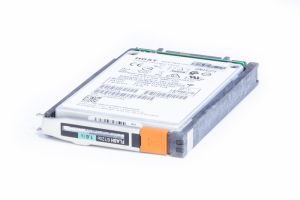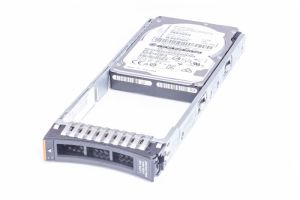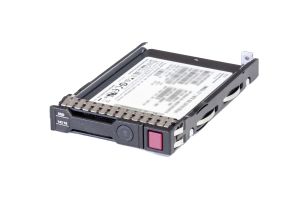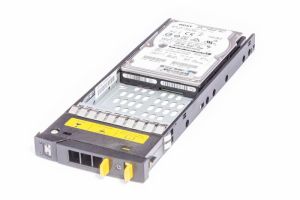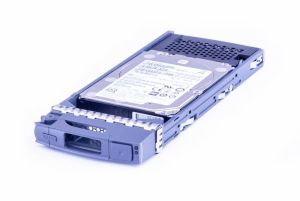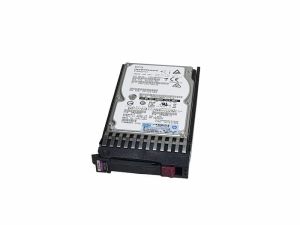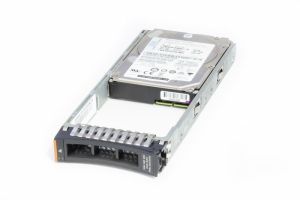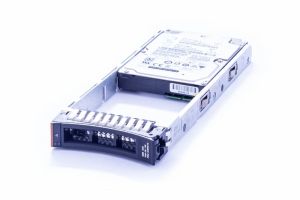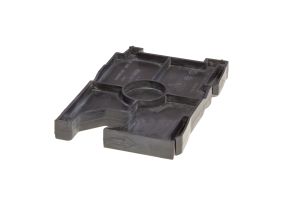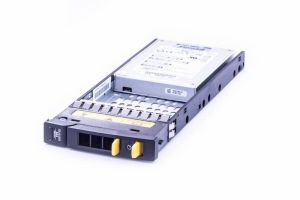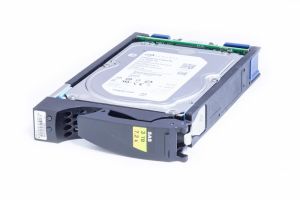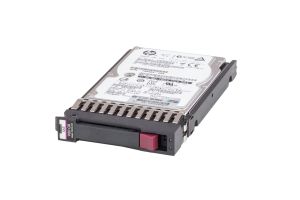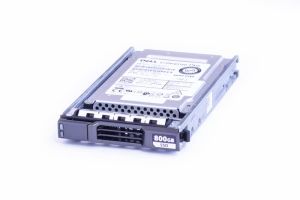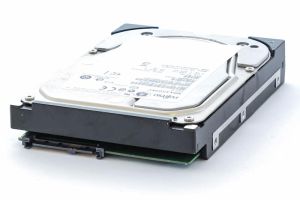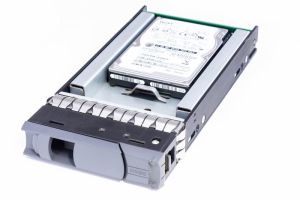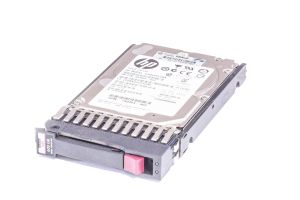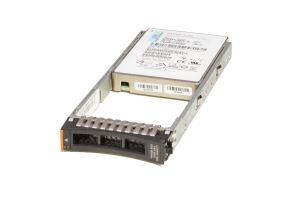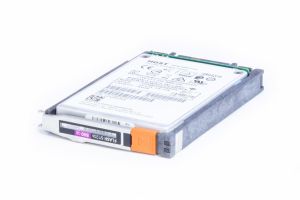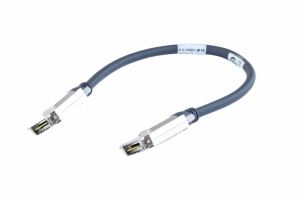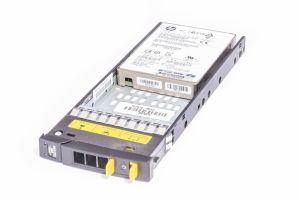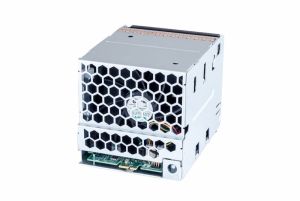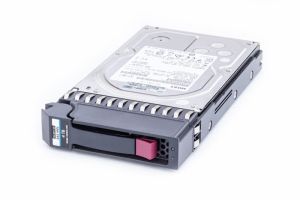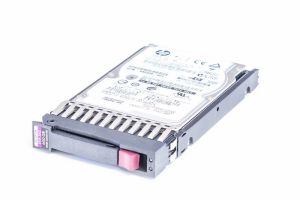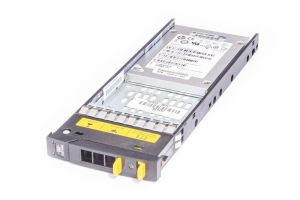Refurbished storage components
Get instant information about our latest offers. Sign up for our newsletter today. You can unsubscribe from the newsletter at any time free of charge.
Buy storage hardware cheap & buy easily at Serverando
The volume of data has increased exponentially in recent years - an optimized storage solution is therefore not only existential for cloud providers. However, long-term and secure storage is also a major challenge for many companies - and also high costs. Efficient and well thought-out security solutions are therefore a must. Archive data should be stored as cost-effectively as possible, data that is crucial for smooth business operations should be accessible in real time. And: If a natural disaster, a fire or a cyber attack has occurred, the damage should be covered by a "Backup & Recovery" plan should be kept as low as possible.
 There is also the question: off with the data in the cloud or would you rather store it on storage servers and disk shelves in your own server room / data center? Cloud vs. on-premises - for many companies, local data storage with its own software and infrastructure is often the winner when it comes to particularly sensitive data. Data and workloads that are not critical to the company migrate to the cloud - if you take the best of both solutions, you create a hybrid system that can complement each other perfectly.
There is also the question: off with the data in the cloud or would you rather store it on storage servers and disk shelves in your own server room / data center? Cloud vs. on-premises - for many companies, local data storage with its own software and infrastructure is often the winner when it comes to particularly sensitive data. Data and workloads that are not critical to the company migrate to the cloud - if you take the best of both solutions, you create a hybrid system that can complement each other perfectly.
But here, too, it is important to know your data and to be able to “characterize” it – e.g. B. through big data analysis tools and automated data management. Because the distinction between cold and hot data (i.e. data that is used less often and that which promotes ongoing operations) can bring enormous savings potential in terms of energy and hardware costs. For a company, the high availability of the data is just as important as top performance and optimal scalability of the data storage.
 It is therefore important to know which type of storage (DAS, SAN or NAS) is best used in your company. It is best to get advice from an IT system house or IT consulting company. Once the "Inhouse Storage" project plan has been completed, the question arises as to how this can be implemented cost-effectively. The topic of sustainability in data centers has also been hotly debated in the past.
It is therefore important to know which type of storage (DAS, SAN or NAS) is best used in your company. It is best to get advice from an IT system house or IT consulting company. Once the "Inhouse Storage" project plan has been completed, the question arises as to how this can be implemented cost-effectively. The topic of sustainability in data centers has also been hotly debated in the past.
So that the optimal storage solution can also be implemented cost-wise for small and medium-sized companies, you can fall back on refurbished hardware from well-known manufacturers. Because our "refurbished" products are technically and optically in perfect condition and have been checked by our expert technicians for "Heart & Kidneys" checked.
And since our "used" items are fed back into the circular economy, their "second life" reduces CO₂ emissions and the consumption of resources that would be required to produce the goods again. So not only easy on your wallet, but also on the environment.
How is hardware storage structured?
We are all familiar with the definition of “storage” – it is a storage solution for storing digital, non-volatile data. But how is such a storage system structured? It is important to know that storage does not mean storage. If we talk purely about the hardware, there are systems that consist of one or more hard drives and a housing (e.g. external hard drive, NAS system) and are purely for the consumer area, e.g. B. are suitable as a backup.
The storage capacity ranges from a few hundred gigabytes to several terabytes. Peanuts, if you think of company sizes. The systems are scaled here from petabytes to exabytes. For high-end storage, however, this also means that it must be possible to expand it quickly and easily - future-oriented thinking when buying hardware storage is therefore white. After all, the required storage space grows with the company expansion.
A few decades ago, data was still stored on CDs, DVDs, tapes and floppy disks, but now disk arrays with HDDs or SSDs, all-flash memory or hybrid systems are used for data backup. But the veterans of data backup, the tape drives, were also allowed to celebrate a revival.
The different storage types result from the connection to the existing IT landscape. DAS (Direct Attached Storage) refers to the systems that e.g. B. can be connected directly to the computer by means of a cable. If several clients are attached to the storage, they can be connected to the storage via an Ethernet switch and server. However, this method makes little sense for the backup/archive area - depending on the IT landscape, existing infrastructure and company/storage size, an NAS (Network Attached Storage) or a SAN (Storage Area Network) system is used.
A high-level overview of how storage and data centers can be classified is the tier topology:
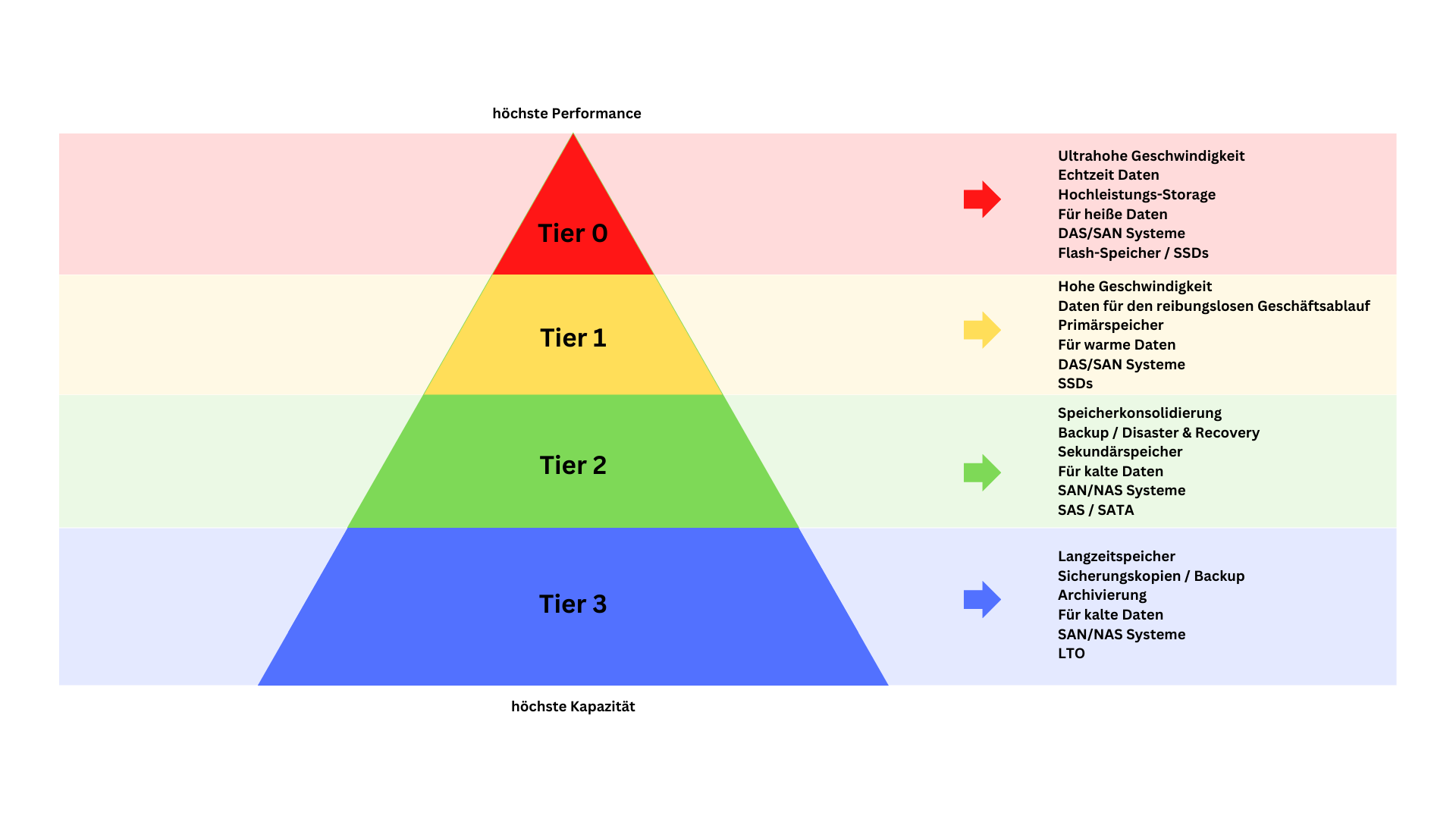
DDAS construction & Hardware for Direct Attached Storage
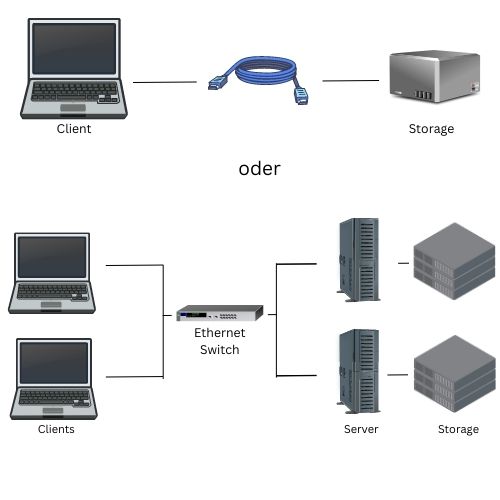 DAS systems are part of the "entry-level storage" and are particularly recommended when there are high demands on performance, but a rather small IT budget is available. Since this is a point-to-point connection, both the latency and the effort involved in setting it up are very low. However, discounts have to be made in terms of scalability. In addition, the distance to the host is very small - here too there may be restrictions for many companies.
DAS systems are part of the "entry-level storage" and are particularly recommended when there are high demands on performance, but a rather small IT budget is available. Since this is a point-to-point connection, both the latency and the effort involved in setting it up are very low. However, discounts have to be made in terms of scalability. In addition, the distance to the host is very small - here too there may be restrictions for many companies.
The systems are connected, for example, via USB, SAS or fiber optic connections (e.g. Fiber Channel Point to Point), which can also bridge greater distances.
One or more control units such as e.g. B. a server or an intelligent "storage head" (also called filer, head or node). In addition, expansion shelves (“JBOD”) with SAS/SATA hard drives or SSDs. Storage servers or small complete systems (RAID systems), which combine the control unit and disk shelves in one housing and manage themselves, are also suitable for smaller companies.
Examples of use as DAS systems include the HP MSA series, the DELL PowerVault systems, the Fujitsu Eternus DX series or Supermicro JBOD Storage.
Appropriate cables and HBAs are also required for the "connection".
NAS setup & Network-attached storage hardware
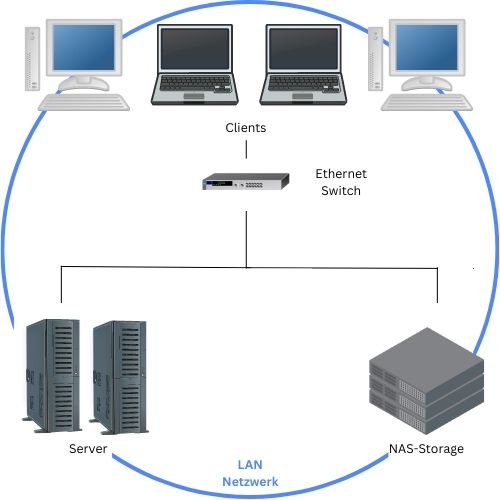 While SAN storage was very popular until recently, the trend is now towards NAS. Because it combines a simple connection (through direct integration into the existing Ethernet structure) with very good performance and high scalability. Because the technology is based on LAN, there is also very good operability. This means that not only clients based on Windows or Linux can access the mass storage, but also that hardware components from different manufacturers "work together" better.
While SAN storage was very popular until recently, the trend is now towards NAS. Because it combines a simple connection (through direct integration into the existing Ethernet structure) with very good performance and high scalability. Because the technology is based on LAN, there is also very good operability. This means that not only clients based on Windows or Linux can access the mass storage, but also that hardware components from different manufacturers "work together" better.
And a lot has also happened in terms of storage technology and media: Thanks to 10Gbit/s transmissions, all-flash systems can also be connected - in addition to file storage, block-based storage technology can also be used. However, a disadvantage can be that the existing LAN network is exposed to such high loads - but here too there are opportunities for improvement, e.g. B. to set up a dedicated storage and separate it via WLAN.
NAS systems are available from various well-known manufacturers, well-known models are e.g. B. the HPE StoreEasy series, the FAS series from NetApp and models from QNAP or Synology. The latter not only offer mass storage in rack format, but also standalone housing for the private sector.
NAS systems with top performance and NVMe compatibility are already on the market - just like Software Defined Storage (SDS), which belongs to the Network Attached Storage sector.
Since the NAS system is connected to standard network controllers via common interfaces, there is a high level of compatibility. 1Gbit/s Ethernet as well as 10Gbits/Ethernet controllers and interfaces such as RJ-45, SFP+, QSFP+ or SFP28 can be used. A selection of high-quality and inexpensive adapters and controller cards can be found here.
SAN construction & Storage area network hardware
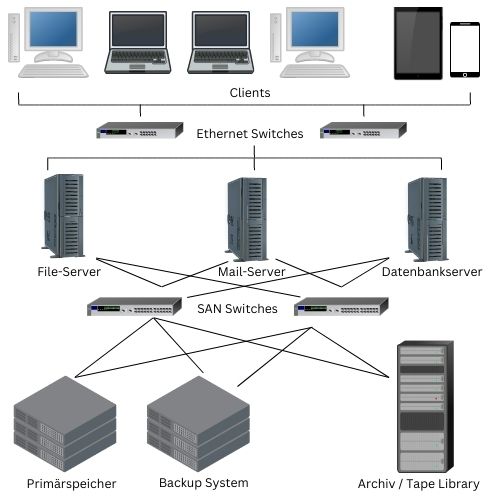 Even if a SAN system can be managed quickly and easily from a central location, the system itself can be extremely complex and often involves having an IT administrator on site. In addition to the existing Ethernet structure, a fiber channel infrastructure must also be implemented. It is possible to connect several mass storage systems as well as access from outside. In addition to performance that is similar to that of DAS systems, SAN also has outstanding scalability.
Even if a SAN system can be managed quickly and easily from a central location, the system itself can be extremely complex and often involves having an IT administrator on site. In addition to the existing Ethernet structure, a fiber channel infrastructure must also be implemented. It is possible to connect several mass storage systems as well as access from outside. In addition to performance that is similar to that of DAS systems, SAN also has outstanding scalability.
In order to provide the servers with more memory, the connection is made via fiber optics - the clients access the servers via Ethernet. InfiniBand models, through which the storage protocols can be transmitted, are less common than FibreChannel switches. The disadvantage here, however, is that unlike the NAS, the LAN technology that has been standardized for decades is not used and - even today - there are certain conflicts and malfunctions between components from different manufacturers.
Here, too, the respective storage system must have included logic - e.g. B. a controller unit and several expansion shelves together in one Rack cabinet. Performance, flexibility and fast scalability play a central role in the construction of the storage area network. Cluster systems and systems for storage virtualization are also possible.
In addition to the hard disk arrays and the logic, network components such as FibreChannel or Infiniband, ie significant. Suitable rails & Accessories such as cables, adapters and Gbics added.
As with DAS and NAS systems, there are a number of different manufacturers to choose from for SAN. The HDD memory (disk arrays), which used to be used for hot data, are now used more as backup systems or for archiving. Flash-based storage systems (“all-flash arrays”) now have SSDs or NVMe modules instead of SAS or SATA hard drives. Well-known manufacturers and models are e.g. B. the HPE MSA SAN Storage models, the NetApp E series, the DELL/EMC VNX series, HPE 3PAR SAN StorageServ, the IBM Storwize (like the v7000 or v3000) or the EqualLogic from Dell.
In addition to the Eternus disk systems, manufacturers such as Fujitsu also have tape libraries in their range. Because even the "dinos" in the storage industry are not dying out - tape storage is a cost-effective solution, especially for long-term data backup and archive data. Because the tapes described can also be stored offline - optimally, you go with the 3-2-1 backup method, which requires three copies - 2 of them in the house and one externally.
Configure storage server online
So if you are looking for a cheap complete device for your data backup, you can put together your desired storage server directly online in our shop. Configure e.g. B. Models like the DL380 Gen9 or Gen10 exactly according to your needs.
 But we don't just have the right storage in stock for smaller companies. We also offer first-class data storage systems for medium-sized to larger companies, which can also be configured as desired. In addition to the control units with logic and controller modules, we also offer matching extension shelves and hard drives or SSDs in our online shop. There are – almost – no limits to the capacities. Because through our worldwide trading network with IT brokers from near and far, we can get offers for your desired system at any time. And not only in the storage area, but also other network components such as switches, network cabinets or controllers and adapters.
But we don't just have the right storage in stock for smaller companies. We also offer first-class data storage systems for medium-sized to larger companies, which can also be configured as desired. In addition to the control units with logic and controller modules, we also offer matching extension shelves and hard drives or SSDs in our online shop. There are – almost – no limits to the capacities. Because through our worldwide trading network with IT brokers from near and far, we can get offers for your desired system at any time. And not only in the storage area, but also other network components such as switches, network cabinets or controllers and adapters.
If a component in your server room fails and is no longer available on the market, or if you would like to expand your existing storage at low cost, but which the manufacturer no longer offers, simply contact us. We only need the desired part number of the spare part in order to be able to make you an offer. Hardware components that are difficult to obtain are also no problem for us - because we carry a wide range of storage accessories, such as cables, HBAs, controller and I/O modules, power supplies, Gbics, FibreChannel and InfiniBand switches and of course SAS or SATA hard drives and SSDs.
Green versus cheap? Ensure more sustainability in the data center with refurbished
Used storage hardware has a number of advantages over new hardware. On the one hand, of course, the big price savings. After all, refurbished storage components are many times (up to 70%) cheaper than new goods. In this way, high-quality and important hardware components for data management and data backup can also be implemented for small and medium-sized companies.
Because if the worst comes to the worst, you want to be well prepared. However, if you rely on devices and hard drives that are not designed for the high-end sector, you are saving in the wrong place. And important company data may not be recoverable. Here, too, the cheap used goods offer another advantage. Because even if a hard disk fails, you can already prepare yourself and buy "offline" disks as a reserve. If an HDD then fails, you already have a replacement in-house and can exchange it directly – without delivery bottlenecks and long package times.
Unfortunately, when or whether a hard drive or other component will be “retired” cannot be said in advance – this happens with new goods just as much as with used ones. With refurbished hardware, however, it can be ruled out that production errors have crept in - after all, the hardware was already in reliable operation and is also checked for functionality again in our in-house technology center "ETA-C" before shipment.
 Low prices, high-quality products that have been thoroughly tested, short delivery times (does not have to be re-produced first) and better availability on the market are probably the main arguments for switching to refurbished hardware. However, there is another important argument that is becoming increasingly important, especially in our time: sustainability.
Low prices, high-quality products that have been thoroughly tested, short delivery times (does not have to be re-produced first) and better availability on the market are probably the main arguments for switching to refurbished hardware. However, there is another important argument that is becoming increasingly important, especially in our time: sustainability.
Because the longer the life cycle of a product, the less it has to be produced from scratch - and the less valuable raw materials such as water or metals are consumed. In addition, the CO₂ emissions are highest during the production of an item - and the disposal rate is reduced if the hardware is fed into the circular economy instead of electronic waste. In our opinion, refurbished used goods can very well be described as more environmentally friendly than new goods. Make the switch too and protect both our environment and your wallet. You can find more information about the "green alternative" in our blog post on this topic .

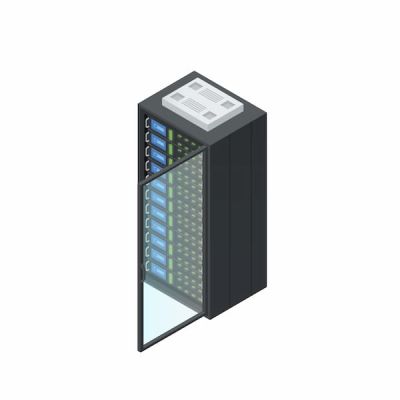
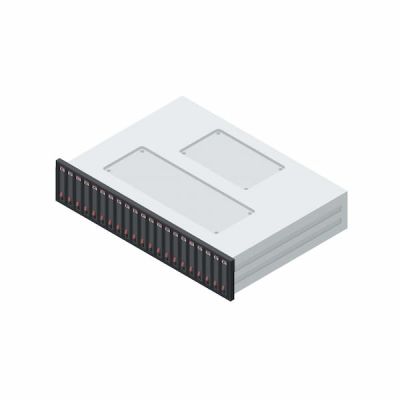
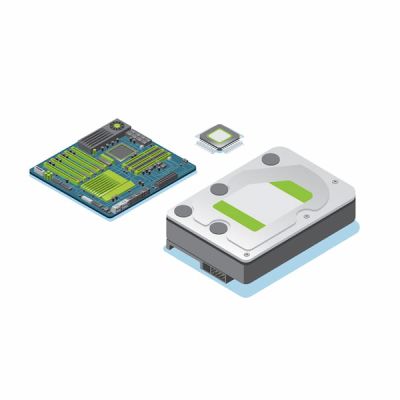
 Server
Server  Storage
Storage  Components
Components  Network
Network  Printer
Printer  Buyback
Buyback  % Sale %
% Sale % 